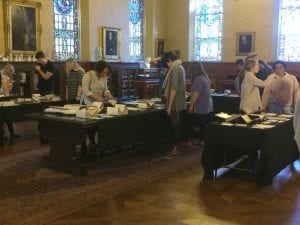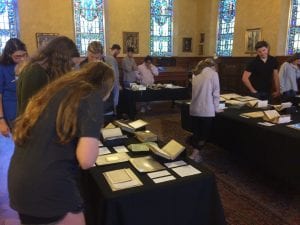The Armstrong Browning Library & Museum’s current exhibit, “The Literary Network of Robert Browning and Elizabeth Barrett Browning” will be coming down on Friday, September 28th. But before it does, we asked Dr. Kristen Pond a few questions about her course on literary networks. We hope you enjoy reading Dr. Pond’s responses and take this final opportunity to drop by and see her students’ hard work while it is still on display.
Where did your interest in literary networks begin and how has it grown or changed?
While periodization is always something that we debate as literary students and scholars, it still organizes the way we teach our classes and the way we divide up the work of research and teaching in each period. I did not really question the notion of periods and all of those survey courses marching linearly through time that I took as an undergraduate. Until, that is, I was taking a Nineteenth Century British Literature survey course and we were looking at William Wordsworth that day. I had just been working on a project for another class on the Victorian period and what was happening in the year 1850. In the class on William Wordsworth the professor hit the highlights of his life and then mentioned he died in 1850. I remember thinking – wait, what?! He is a Romantic poet but he was alive at the height of the Victorian period. Then I looked at the publication dates of his work and noticed how many of them were in the Victorian, not the Romantic, period. This was the beginning of the tension I feel in cordoning off time periods and putting writers in boxes accordingly.
This interest has changed in focus slightly from the issue of dating to the issue of networks itself. These authors did not write alone or in isolation, but they had important networks of friends, family, and peers that had a vital influence on the kind of works they produced. I discovered most of these networks through my interest in minor writers, usually female, that get left out of the canon. Once you start exploring these women you begin to realize just how connected they are to the “major” male writers that tend to make it on course syllabi. Dorothy Wordsworth is perhaps the most famous example, and she is in fact often included in anthologies now (though clearly as the minor counterpart to her brother William). Thinking about the Brownings or the Shelleys as couples who formed literary networks is fun, and of course there are lots of groups who were well known enough to have earned names, such as the Lake School, the Cockney School, and the Bloomsbury group.
What do you enjoy most as you teach students about authors’ literary networks?
I most enjoy teaching my literature survey courses as networks because students begin to see these authors as human beings. For some reason, I think this creates a different comfort level where students feel able to respond and critique their work. A poem no longer becomes this perfect historical artifact preserved for its perfection, but a work in progress created out of joy and pain in the company (and through the critique) of others. I also enjoy the confusion that emerges from the messiness of trying to learn in a pattern that is not linear but circular and recursive. It is a productive chaos J.
How have students responded to the literary networks exhibit assignment?
Students in general seem to really enjoy a different approach to a literary time period. They always have some new insight they learn specifically from the design set-up, an insight that they would not have gleaned from a traditional march through time looking at writers in isolation. Students also gain a lot from working with the library archives and collections. I have had numerous students go on to graduate school for library science because they realized their passion for working with those kinds of materials.


